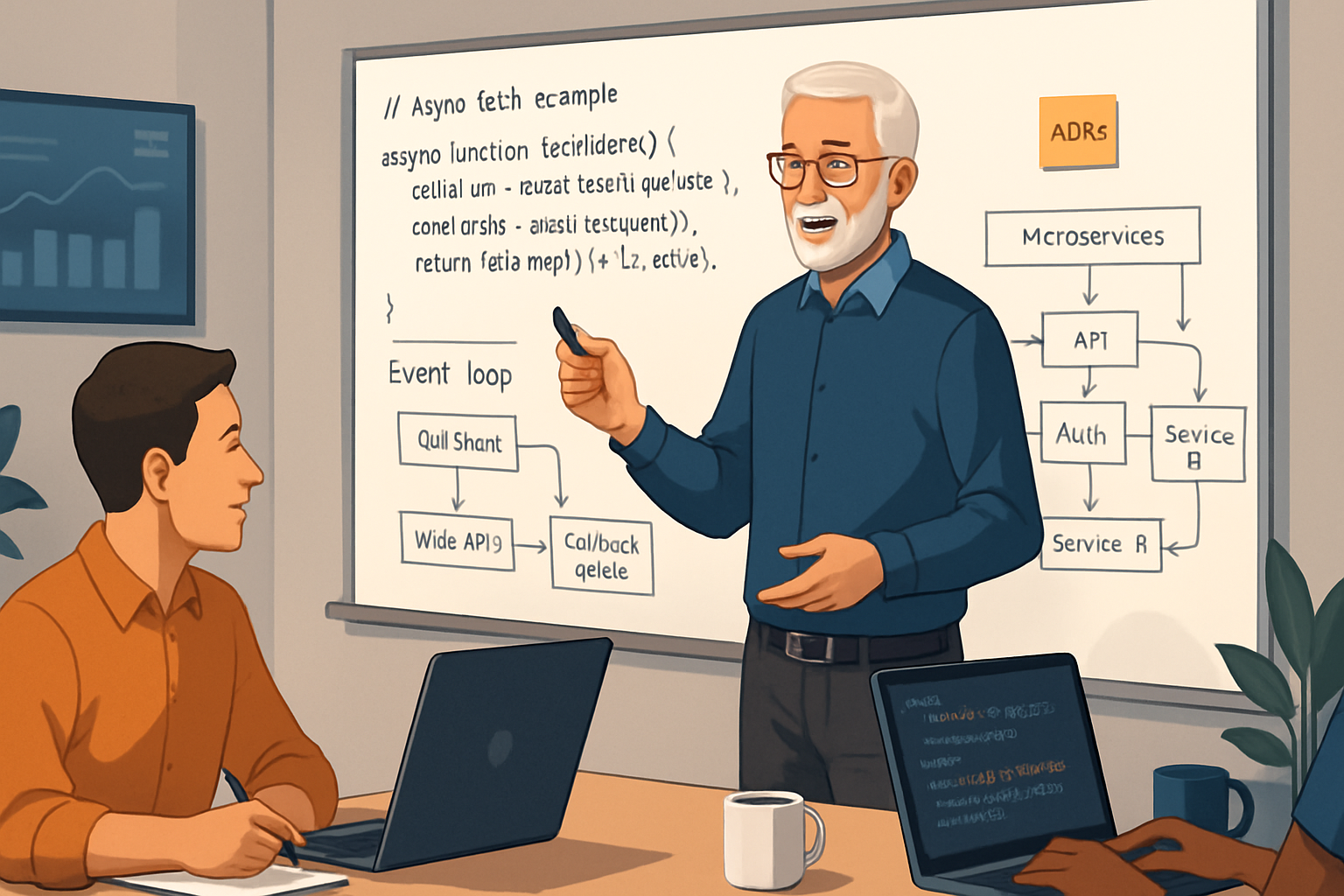· career · 7 min read
The Unwritten Skills: What Senior JavaScript Developers Know That You Don’t
Beyond syntax and frameworks lies a set of soft skills and advanced problem-solving habits that separate senior JavaScript developers from the rest. This article maps those unwritten skills - emotional intelligence, mentorship, strategic thinking, debugging rituals, production responsibility - and gives concrete ways to practice them today.

Outcome-first: by the end of this article you’ll be able to think and act like a senior JavaScript developer - not because you memorized more APIs, but because you adopted habits and perspectives that change how you solve problems, influence teams, and own outcomes.
Why this matters: companies don’t pay for lines of code. They pay for reliable features, reduced risk, faster learning, and teams that get better. Senior developers produce those outcomes by blending technical craft with interpersonal judgment. Read on to see the unwritten skills that actually move the needle.
The core difference: responsibility over tasks
Junior developers see tasks. Seniors see outcomes. That sentence is short. It should sting.
A task is a ticket. An outcome is the behavior your users experience, the latency your service must meet, the maintenance burden your team will carry for years. Senior developers habitually convert tickets into outcomes - they expand their scope to include monitoring, rollback plans, communication with stakeholders, and follow-through after deployment.
If you want to level up, start by asking: what could go wrong after this ships? Then answer it before you commit the code.
Emotional intelligence: the invisible API
Technical skills are visible. Emotional intelligence (EQ) is not. Yet it’s the most frequent multiplier of influence.
What senior devs do differently with EQ:
- They read the room. They know when to push, when to hold back, and when to ask questions to reduce friction.
- They frame feedback as shared problem-solving, not personal critique.
- They surface hard trade-offs to stakeholders instead of pretending uncertainty doesn’t exist.
Practical habits to build EQ:
- Use the SBI model for feedback: Situation, Behavior, Impact. Concrete beats vague.
- Practice active listening in standups - paraphrase what you heard before responding.
- Run a short emotional check-in in meetings (“one-word check - how’s everyone doing?”) to surface blockers early.
Resources: Learn the basics of emotional intelligence from Daniel Goleman’s work for concepts and practical framing: https://www.danielgoleman.info
Mentorship as a multiplier - teach to scale
Seniors don’t hoard knowledge. They create leverage.
Why mentorship matters:
- The fastest way to raise team velocity is to make one teammate better.
- Teaching clarifies your own thinking - you find hidden assumptions and simplify complex ideas.
Mentorship tactics that work:
- Pair intentionally: one-hour focused sessions on a single concept beat random ad-hoc pairing.
- Give micro-goals in code reviews: point to one improvement and one thing done well.
- Design small learning paths: three readings, two exercises, one code task. Measure progress.
Make feedback actionable. Instead of “this is messy,” say: “Extract this chunk into a function with a descriptive name and add a unit test for edge case X.”
Decision framing: don’t design by accident
Seniors document decisions. They don’t assume the future will magically remember why something was chosen.
Tools and habits:
- Write Architecture Decision Records (ADRs). A short ADR answers: What is the decision? Why now? What alternatives were considered? What are the consequences? See https://adr.github.io for patterns.
- Use lightweight design docs for non-trivial features. A one-page doc reduces rework by forcing explicit trade-offs.
- Timebox decisions. If a choice isn’t critical, prefer the simpler, reversible option.
Why this helps: ADRs create institutional memory. They turn gut choices into explainable, revisitable decisions.
Debugging and problem-solving rituals
A senior developer has a toolkit of reproducible debugging rituals. They don’t guess; they methodically reduce the problem space.
A reproducible debugging recipe:
- Reproduce the problem with the smallest possible example.
- Gather evidence: logs, network traces, user steps, environment.
- Bisect the change set (git bisect or manual narrowing) to find when the behavior started.
- Form hypotheses and design minimal experiments to disprove them.
- Fix, write a test (if appropriate), and add observability to detect regressions.
Concrete JavaScript tips:
- Use source maps and Chrome DevTools performance/heap profiling for front-end issues: https://developer.mozilla.org/en-US/docs/Web/JavaScript/Debugging
- For Node apps, add structured logging and correlation IDs for requests to trace flows across services.
- When memory issues appear, capture heap snapshots and compare them to find leaks.
Shortcuts are dangerous. The cost of a bad assumption is usually paid later by someone else - often you.
Observability and production thinking
Seniors treat production systems as the primary source of truth.
Key practices:
- Instrument first. Add logs, metrics, and traces as you add features. If it’s worth shipping, it’s worth measuring.
- Define SLIs and SLOs for critical flows. Don’t rely solely on “doesn’t crash” as a success metric. See the Google SRE book for SLO concepts: https://sre.google/sre-book/table-of-contents/
- Automate alerting thresholds to catch regressions early and reduce noise.
Remember: shipping without observability is like driving at night without headlights.
Code review as craft, not gatekeeping
Seniors use code reviews to teach, enforce standards, and reduce risk - not to flex expertise.
Effective review patterns:
- Start with positives. Name what’s done well. That builds receptivity.
- Ask clarifying questions rather than issuing demands. Encourage the author to explain intent.
- Focus reviews on behavior and surface area: maintainability, correctness, test coverage, and performance implications. Style issues should be automated (linters, formatters).
A good review ends with a clear next step: approve, request small change, or ask for a rework with a checklist.
Strategic thinking: trade-offs, not absolutes
Senior developers weigh trade-offs in multiple dimensions: time, reliability, maintainability, and future work.
Questions seniors ask before designing:
- What’s the expected lifetime of this system? Prototype vs. long-lived service?
- Who will maintain this code? What is their expertise?
- How likely is this code to change? Use polymorphism or data-driven approaches for evolving logic.
Pattern: prefer reversible changes. Feature flags, migration scripts, and dark launches let you test assumptions in production safely.
Communication with non-technical stakeholders
Seniors translate technical risk into business impact. They don’t drown stakeholders in detail. They make the trade-offs visible.
Communication habits:
- Use plain language: “This takes two weeks because we must migrate the database, which requires downtime.”
- Offer options with consequences: “We can do A (fast, risk X), or B (slower, lower risk).”
- Deliver bad news early with a mitigation plan.
This builds trust. Trust converts technical recommendations into funded work.
Hiring and team composition instincts
Seniors know how to spot signals, not just keywords on a resume.
Interview heuristics:
- Look for learning velocity: how did the candidate learn a recent skill?
- Behavior over trivia: ask for concrete examples of times they handled ambiguity, conflict, or a production incident.
- Small tasks with explain-your-thoughts reveal mental models better than trivia quizzes.
Hiring is a leadership responsibility. A wrong hire costs months. Seniors bias toward patterns that reveal thinking.
Security, privacy, and technical debt as first-class concerns
Seniors don’t treat security as an afterthought. They bake it into design and code reviews.
Practical steps:
- Treat sensitive data as if it will leak: Minimize storage, encrypt in transit and at rest, and log access.
- Automate dependency checks and vulnerability scanning.
- Maintain a technical debt register. Treat debt like a product backlog item with priority and cost estimates.
Small investments in security and debt management compound into fewer emergencies.
Rituals that build senior instincts (daily, weekly, quarterly)
Daily
- Run and read your application’s basic health metrics.
- Triage one newly surfaced user issue end-to-end.
Weekly
- Do one focused pairing or mentoring session.
- Spend an hour reading code outside your stack.
Quarterly
- Run a pre-mortem on major upcoming releases.
- Review and update ADRs and the technical debt register.
Rituals wire good instincts into your brain. They reduce random heroics and create repeatable outcomes.
Mini case study: a shipping incident turned into a lesson
Scenario: a new feature caused intermittent 500 errors in production after deployment. The junior response was to revert immediately; the senior approach looked different.
Senior sequence:
- Rapidly gather evidence (logs, traces, user repro steps).
- Toggle the feature flag (minimize impact).
- Correlate errors with recent changes using a bisect-like approach.
- Ship a targeted fix and add a regression test.
- Run a blameless postmortem and add an ADR noting the root cause and chosen mitigation.
Outcome: faster recovery, fewer user-facing regressions, and a documented fix that prevents recurrence.
Practice plan: six actions to adopt this week
- Write one short ADR for a recent decision.
- Add a single meaningful metric for a feature you worked on.
- Give structured feedback on one PR (SBI model).
- Pair for one hour on a non-trivial bug and alternate driving.
- Run a one-page pre-mortem for your next release.
- Automate one lint or test check that you currently do manually.
Small, consistent steps beat a single heroic effort.
Final thought - the strongest unwritten skill
You can learn frameworks and APIs quickly. You can memorize patterns and tools. What separates senior developers is the habit of taking responsibility for outcomes: technical, human, and operational. That habit changes what you measure, how you communicate, and where you spend your time.
Senior developers don’t just write code. They own the consequences of shipping it.


